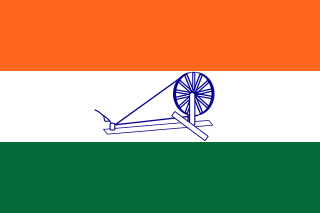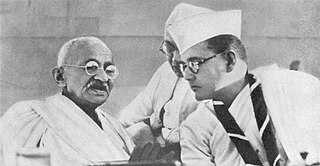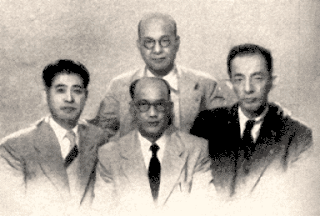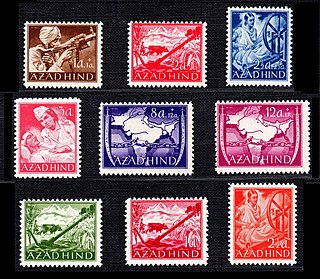Related Research Articles

The Indian National Army was a collaborationist armed unit of Indian collaborators that fought under the command of the Japanese Empire. It was founded by Mohan Singh on 1 September 1942 in Southeast Asia during World War II.

Subhas Chandra Bose was an Indian nationalist whose defiance of British authority in India made him a hero among many Indians, but his wartime alliances with Nazi Germany and Imperial Japan left a legacy vexed by authoritarianism, anti-Semitism, and military failure. The honorific Netaji was first applied to Bose in Germany in early 1942—by the Indian soldiers of the Indische Legion and by the German and Indian officials in the Special Bureau for India in Berlin. It is now used throughout India.

The Provisional Government of Free India or, more simply, Azad Hind, was a short-lived Japanese-supported provisional government in India. It was established in Japanese occupied Singapore during World War II in October 1943 and has been considered a puppet state of the Empire of Japan.

Netaji Subhas Chandra Bose: The Forgotten Hero is a 2004 Indian epic biographical war film, written and directed by Shyam Benegal. The film starred an ensemble cast of Sachin Khedekar, Kulbhushan Kharbanda, Rajit Kapur, Arif Zakaria, and Divya Dutta, among others. The film depicts the life of the Indian Independence leader Subhas Chandra Bose in Nazi Germany: 1941–1943, and In Japanese-occupied Asia 1943–1945, and the events leading to the formation of Azad Hind Fauj.

The Indian Legion, officially the Free India Legion or 950th (Indian) Infantry Regiment, was a military unit raised during the Second World War initially as part of the German Army and later the Waffen-SS from August 1944. Intended to serve as a liberation force for British-ruled India, it was made up of Indian prisoners of war and expatriates in Europe. Due to its origins in the Indian independence movement, it was known also as the "Tiger Legion", and the "Azad Hind Fauj". As part of the Waffen-SS it was known as the Indian Volunteer Legion of the Waffen-SS.

Anita Bose Pfaff is an Austrian-born economist, who has previously been a professor at the University of Augsburg as well as a politician in the Social Democratic Party of Germany. She is the daughter of Indian nationalist Subhas Chandra Bose (1897–1945) and his wife Emilie Schenkl.

Subhas Chandra Bose 's political views were in support of complete freedom for India with a classless society and state socialism at the earliest, whereas most of the Congress Committee wanted it in phases, through a Dominion status.

Major General Mohammed Zaman Kiani was an officer of the British Indian Army who later joined the Indian National Army (INA), led by Subhas Chandra Bose, and commanded its 1st Division.
Abid Hasan Safrani, IFS, born Zain-al-Abdin Hasan, was an officer of the Indian National Army (INA) and later, after 1947, an Indian diplomat. He famously introduced the slogan 'Jai Hind' translating to 'victory belongs to India' that is being used for official and semi-official purposes including army salutes, moral upliftment and in pop culture movies extensively.

Subbier Appadurai Ayer was the Minister for Publicity and Propaganda in Subhas Chandra Bose's Azad Hind Government between 1943 and 1945, and later a key defence witness during the first of the INA trials. Ayer had travelled to Bangkok in November 1940 as a Special correspondent for Reuters before joining the Indian Independence League. In October 1943, Ayer was appointed the Minister of publicity and propaganda in the nascent Azad Hind Government.
The First Indian National Army was the Indian National Army as it existed between February and December 1942. It was formed with Japanese aid and support after the Fall of Singapore and consisted of approximately 12,000 of the 40,000 Indian prisoners of war who were captured either during the Malayan campaign or surrendered at Singapore. It was formally proclaimed in April 1942 and declared the subordinate military wing of the Indian Independence League in June that year. The unit was formed by Mohan Singh. The unit was dissolved in December 1942 after apprehensions of Japanese motives with regards to the INA led to disagreements and distrust between Mohan Singh and INA leadership on one hand, and the League's leadership, most notably Rash Behari Bose. Later on, the leadership of the Indian National Army was handed to Subhas Chandra Bose. A large number of the INAs initial volunteers, however, later went on to join the INA in its second incarnation under Subhas Chandra Bose.

The Azad Hind stamps are a set of prepared but never issued stamps for the planned Provisional Government of Free India under Subhas Chandra Bose. All stamps were printed by photogravure in sheets of 100 at the Reichsdruckerei, the Government Printing Bureau in Berlin.
Habib ur Rahman (1913–1978) was an army officer in the Indian National Army (INA) who was charged with "waging war against His Majesty the King Emperor". He served as Subhas Chandra Bose's chief of staff in Singapore, and accompanied Bose on his alleged last fatal flight from Taipei to Tokyo, sharing the last moments of his life. Rahman also played an important role in the First Kashmir War. Convinced that Maharaja Hari Singh was out to exterminate the Muslims of Jammu and Kashmir, he joined Major General Zaman Kiani, in launching a rebellion against the Maharaja from Gujrat in Pakistani Punjab. Rehman and his volunteer force launched an attack on the Bhimber town. But, the records of the 11th Cavalry of the Pakistan Army indicate that their efforts did not succeed, and eventually the Cavalry was responsible for conquering Bhimber.

Mohammad Iqbal Shedai was a British Indian and later Pakistani activist who espoused independence for India and opposition to British colonial policies. He spent most of his life in self-exile in Asian and European countries.

Arathil Candeth Narayanan Nambiar was an Indian Nationalist and a friend and colleague of Subhas Chandra Bose. Originally from Kerala, Nambiar spent much of his life serving the Indian independence movement in Europe.

Throughout World War II, both the Axis and Allied sides used propaganda to sway the opinions of Indian civilians and troops, while at the same time Indian nationalists applied propaganda both within and outside India to promote the cause of Indian independence.

The Free India Centre was the European branch of the Azad Hind, provisional government led by Subhas Chandra Bose. It was founded by Bose when he was in Nazi Germany in 1942, and headed by A. C. N. Nambiar.
The Indian National Army (INA) and its leader Subhash Chandra Bose are popular and emotive topics within India. From the time it came into public perception in India around the time of the Red Fort Trials, it found its way into the works of military historians around the world. It has been the subject of a number of projects, of academic, historical and of popular nature. Some of these are critical of the army, some — especially of the ex-INA men — are biographical or autobiographical, while still others historical and political works, that tell the story of the INA. A large number of these provide analyses of Subhas Chandra Bose and his work with the INA.
The INA treasure controversy relates to alleged misappropriation by men of Azad Hind of the Azad Hind fortune recovered from belongings of Subhas Chandra Bose in his last known journey. The treasure, a considerable amount of gold ornaments and gems, is said to have been recovered from Bose's belongings following the fatal plane crash in Formosa that reportedly killed him, and taken to men of Azad Hind then living in Japan. The Indian government was made aware of a number of these individuals allegedly using part of the recovered treasure for personal use. However, despite repeated warnings from Indian diplomats in Tokyo, Nehru is said to have disregarded allegations that men previously associated with Azad Hind misappropriated the funds for personal benefit. Some of these are said to have travelled to Japan repeatedly with the approval of Nehru government and were later given government roles implementing Nehru's political and economic agenda. A very small portion of the alleged treasure was repatriated to India in the 1950s.

Netaji Jayanti or Netaji Subhas Chandra Bose Jayanti, officially known as Parakram Diwas or Parakram Divas, is a national event celebrated in India to mark the birthday of the prominent Indian freedom fighter Netaji Subhas Chandra Bose. It is celebrated annually on 23 January. He played a pivotal role in Indian independence movement. He was the head of Indian National Army. He was the founder-head of the Azad Hind Government.
References
- ↑ "Netaji's Addresses on Azad Hind Radio". oocities.org. Retrieved 19 February 2014.
- ↑ Afridi, Sahroz. "Freedom struggle on air". Hindustan Times. Archived from the original on 13 March 2014. Retrieved 19 February 2014.
- ↑ "Netaji to come alive on Azad Hind Radio". newindianexpress.com. Retrieved 19 February 2014.
- 1 2 3 4 5 Jha, Fiza (23 January 2020). "Azad Hind Radio, from where Subhas Chandra Bose spoke his mann ki baat". ThePrint. Retrieved 28 August 2022.
- ↑ Morley, Nathan (15 June 2021). Radio Hitler: Nazi Airwaves in the Second World War. Amberley Publishing Limited. ISBN 978-1-3981-0447-1.
- ↑ de Normann, Roderick (1997). "INFANTRY REGIMENT 950—GERMANY'S INDIAN LEGION". Journal of the Society for Army Historical Research. 75 (303): 172–190. ISSN 0037-9700. JSTOR 44230078.
- ↑ Morley, Nathan (15 June 2021). Radio Hitler: Nazi Airwaves in the Second World War. Amberley Publishing Limited. ISBN 978-1-3981-0447-1.
- 1 2 "Special galleries on Netaji - Azad Hind radio paraphernalia on display". www.telegraphindia.com. Retrieved 28 August 2022.
- ↑ "The Asia Society - Princes and Painters Exhibit". The Asia Society - Princes and Painters Exhibit. Retrieved 28 August 2022.
- 1 2 Morse, Daniel Ryan (10 November 2020). Radio Empire: The BBC's Eastern Service and the Emergence of the Global Anglophone Novel. Columbia University Press. ISBN 978-0-231-55259-2.
- ↑ D'souza, Eugene J. (1 May 2000). "Nazi Propaganda in India". Social Scientist. 28 (5/6): 77–90. doi:10.2307/3518181. JSTOR 3518181.

